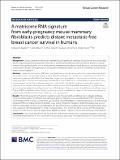Notice
This is not the latest version of this item. The latest version can be found at:https://dspace.mit.edu/handle/1721.1/132704.2
A matrisome RNA signature from early-pregnancy mouse mammary fibroblasts predicts distant metastasis-free breast cancer survival in humans
| dc.contributor.author | Ibrahim, Ayman M. | |
| dc.contributor.author | Bilsland, Alan | |
| dc.contributor.author | Rickelt, Steffen | |
| dc.contributor.author | Morris, Joanna S. | |
| dc.contributor.author | Stein, Torsten | |
| dc.date.accessioned | 2021-10-04T18:41:13Z | |
| dc.date.available | 2021-10-04T18:41:13Z | |
| dc.date.issued | 2021-09 | |
| dc.identifier.issn | 1465-542X | |
| dc.identifier.uri | https://hdl.handle.net/1721.1/132704 | |
| dc.description.abstract | Background During pregnancy, the mouse mammary ductal epithelium branches and grows into the surrounding stroma, requiring extensive extracellular matrix (ECM) and tissue remodelling. It therefore shows parallels to cancer invasion. We hypothesised that similar molecular mechanisms may be utilised in both processes, and that assessment of the stromal changes during pregnancy-associated branching may depict the stromal involvement during human breast cancer progression. Methods Immunohistochemistry (IHC) was employed to assess the alterations within the mouse mammary gland extracellular matrix during early pregnancy when lateral branching of the primary ductal epithelium is initiated. Primary mouse mammary fibroblasts from three-day pregnant and age-matched non-pregnant control mice, respectively, were 3D co-cultured with mammary epithelial cells to assess differences in their abilities to induce branching morphogenesis in vitro. Transcriptome analysis was performed to identify the underlying molecular changes. A signature of the human orthologues of the differentially expressed matrisome RNAs was analysed by Kaplan–Meier and multi-variate analysis in two large breast cancer RNA datasets (Gene expression-based Outcome for Breast cancer Online (GOBO) und Kaplan–Meier Plotter), respectively, to test for similarities in expression between early-pregnancy mouse mammary gland development and breast cancer progression. Results The ECM surrounding the primary ductal network showed significant differences in collagen and basement membrane protein distribution early during pregnancy. Pregnancy-associated fibroblasts (PAFs) significantly enhanced branching initiation compared to age-matched control fibroblast. A combined signature of 64 differentially expressed RNAs, encoding matrisome proteins, was a strong prognostic indicator of distant metastasis-free survival (DMFS) independent of other clinical parameters. The prognostic power could be significantly strengthened by using only a subset of 18 RNAs (LogRank P ≤ 1.00e−13; Hazard ratio (HR) = 2.42 (1.8–3.26); p = 5.61e−09). The prognostic power was confirmed in a second breast cancer dataset, as well as in datasets from ovarian and lung cancer patients. Conclusions Our results describe for the first time the early stromal changes that accompany pregnancy-associated branching morphogenesis in mice, specify the early pregnancy-associated molecular alterations in mouse mammary fibroblasts, and identify a matrisome signature as a strong prognostic indicator of human breast cancer progression, with particular strength in oestrogen receptor (ER)-negative breast cancers. | en_US |
| dc.publisher | BioMed Central | en_US |
| dc.relation.isversionof | https://doi.org/10.1186/s13058-021-01470-3 | en_US |
| dc.rights | Creative Commons Attribution | en_US |
| dc.rights.uri | https://creativecommons.org/licenses/by/4.0/ | en_US |
| dc.source | BioMed Central | en_US |
| dc.title | A matrisome RNA signature from early-pregnancy mouse mammary fibroblasts predicts distant metastasis-free breast cancer survival in humans | en_US |
| dc.type | Article | en_US |
| dc.identifier.citation | Ibrahim, A.M., Bilsland, A., Rickelt, S. et al. A matrisome RNA signature from early-pregnancy mouse mammary fibroblasts predicts distant metastasis-free breast cancer survival in humans. Breast Cancer Res 23, 90 (2021) | en_US |
| dc.relation.journal | Breast Cancer Research | en_US |
| dc.eprint.version | Final published version | en_US |
| dc.type.uri | http://purl.org/eprint/type/JournalArticle | en_US |
| eprint.status | http://purl.org/eprint/status/PeerReviewed | en_US |
| dc.date.updated | 2021-10-03T03:08:19Z | |
| dc.language.rfc3066 | en | |
| dc.rights.holder | The Author(s) | |
| dspace.date.submission | 2021-10-03T03:08:19Z | |
| mit.journal.volume | 23 | en_US |
| mit.journal.issue | 90 | en_US |
| mit.license | PUBLISHER_CC | |
| mit.metadata.status | Authority Work and Publication Information Needed | en_US |
